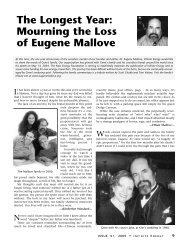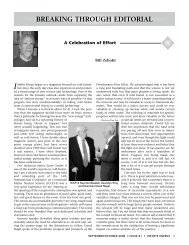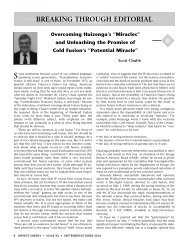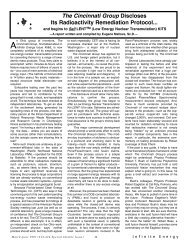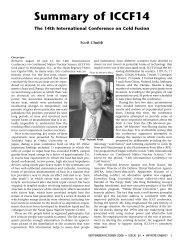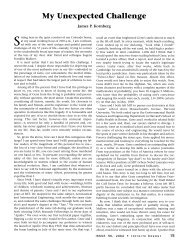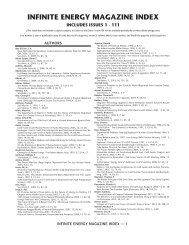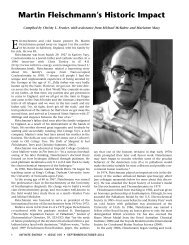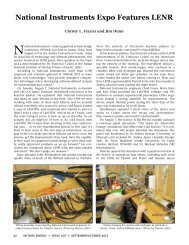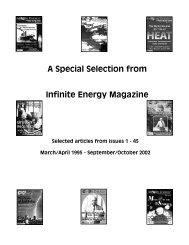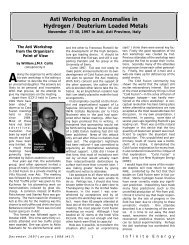MIT and Cold Fusion: A Special Report - Infinite Energy Magazine
MIT and Cold Fusion: A Special Report - Infinite Energy Magazine
MIT and Cold Fusion: A Special Report - Infinite Energy Magazine
Create successful ePaper yourself
Turn your PDF publications into a flip-book with our unique Google optimized e-Paper software.
esident skeptics waiting for government funding? No, they don’t<br />
really want to be bothered with this research. Even if they were<br />
inspired to do it, they wouldn’t get the money, of course. The<br />
skeptics who influence <strong>and</strong> control DoE’s purse strings have<br />
made sure of that. What follows is the untenable <strong>and</strong> unscientific<br />
position of DOE, as stated by Secretary of <strong>Energy</strong> Admiral<br />
James Watkins in a recent speech (May 6, 1991). This attitude came<br />
about not of course exclusively from, but in no small way through<br />
the efforts of influential members of the <strong>MIT</strong> community:<br />
“Remember cold fusion? Front page news for weeks on end.<br />
Will it work or won’t it? Is it the key to our energy freedom,<br />
or a hyped-up hoax? In the end, it was neither. Just bad science.<br />
But how was the public to form an opinion when the<br />
scientific community itself <strong>and</strong> the<br />
reporters who covered the story<br />
were unable to persuasively lay out<br />
the scientific merits of the issue.”<br />
“But there was damage done here<br />
too. Two members of the scientific<br />
community made everyone in<br />
white lab coats look fraudulent.<br />
Congress held hearings <strong>and</strong> railed<br />
Sec. of <strong>Energy</strong><br />
Admiral Watkins<br />
against my agency <strong>and</strong> others for<br />
not pouring millions into cold<br />
fusion, in the process shedding no<br />
light on the real underlying issues of energy production <strong>and</strong><br />
use. And at the same time, they cut my department’s budget<br />
for real fusion energy by $50 million.”<br />
I am aware of some relatively quiet cold fusion work done by<br />
staff members of <strong>MIT</strong>, that was conducted discretely off campus.<br />
There were also a few efforts carried out at Lincoln Laboratory.<br />
Some anomalies were seen, <strong>and</strong> interest there thankfully has<br />
not died completely. [Ed. Note: Definite excess energy later was<br />
observed at Lincoln Labs, but the results have been withheld<br />
from the public.—EFM] But there has been no other significant<br />
experimental work, as far as I am aware. This is disappointing,<br />
but not surprising. Professor Ronald R. Parker, one of the two<br />
professors who led the limited <strong>MIT</strong> cold fusion experimental<br />
effort from late March to late May, was quoted in his letter to<br />
author Robin Herman (<strong>Fusion</strong>: The<br />
Search for Endless <strong>Energy</strong>, 1990). Her<br />
book has a concluding chapter mocking<br />
cold fusion in which Professor<br />
Parker is quoted. “Unfortunately, a<br />
lot of time <strong>and</strong> effort has been wasted<br />
due to this blunder.” I was amazed to<br />
discover that when this statement<br />
was made (May 11, 1989), the experiments<br />
to explore cold fusion at <strong>MIT</strong><br />
had not even been completed.<br />
Though there has been no laboratory<br />
work since the spring of 1989, cold<br />
fusion has been the butt of jokes <strong>and</strong><br />
the focus of merriment at <strong>MIT</strong>. At the<br />
Plasma <strong>Fusion</strong> Center in the summer<br />
of 1989, a “Wake for <strong>Cold</strong> <strong>Fusion</strong>”<br />
party was held. One of the <strong>MIT</strong><br />
reviewers for a major publication<br />
[Nature] that has blocked numerous<br />
attempts by researchers with positive<br />
cold fusion results to publish them,<br />
once was known in this area by an<br />
Robert Birgeneau<br />
editor of that publication as,<br />
“Rambo.” [This was Dr. Richard Petrasso of the <strong>MIT</strong> PFC] The<br />
head of the Physics Department [Prof. Robert Birgeneau]<br />
remarked with humor <strong>and</strong> pride in the summer of 1989 department<br />
newsletter, “I should like to note, however, that none of<br />
our faculty contributed to the confusion surrounding ‘cold<br />
fusion.’”<br />
There have been other remarkable comments. “Garbage”<br />
was how one <strong>MIT</strong> physics professor [Prof. Martin Deutsch]<br />
bluntly characterized cold fusion work to a prominent science<br />
magazine [Science News] in 1989. One of the researchers who<br />
was on the Plasma <strong>Fusion</strong> Center/Chemistry Department team<br />
evaluating cold fusion [Prof. Ronald Ballinger] told me five<br />
months ago that he thought Pons <strong>and</strong> Fleischmann were<br />
“crooks who should be put in jail.” Another team member, Dr.<br />
Richard Petrasso, was quoted recently on the front page of the<br />
New York Times (March 17): “I was convinced for a while it was<br />
absolute fraud. Now I’ve softened. They [Pons <strong>and</strong> Fleischmann]<br />
probably believed in what they were doing. But how<br />
they represented it was a clear violation of how science should<br />
be done.” Apparently another skeptical physicist could not<br />
sanction that severe charge. In a letter to the New York Times<br />
printed April 9, 1991, Yale physicist Robert Kemp Adair wrote:<br />
“Last November, I served on a a committee that met with Dr.<br />
Pons in a review of the National <strong>Cold</strong> <strong>Fusion</strong> Institute at the<br />
University of Utah. Though I concluded that he <strong>and</strong> Dr. Fleischmann<br />
had seen no cold fusion, I am confident they reported<br />
no invented data <strong>and</strong> committed no egregious breach of scientific<br />
ethics.” Unfortunately, the insinuation of fraud applied to<br />
these researchers was given early impetus here.<br />
Recently, the attacks took an uglier turn both from within <strong>and</strong><br />
from outside <strong>MIT</strong>. Physicists Dr. Frederick Mayer <strong>and</strong> Dr. John<br />
Reitz of Ann Arbor, Michigan—both with distinguished scientific<br />
careers—were invited to <strong>MIT</strong> by Professors Peter Hagelstein<br />
<strong>and</strong> Lawrence Lidsky—to conduct a scientific seminar<br />
about their theory of “cold fusion” that appeared in their<br />
“Nuclear <strong>Energy</strong> Release in Metals” paper, which has been published<br />
in <strong>Fusion</strong> Technology. The seminar was advertised in the<br />
usual channels on campus. To my knowledge, since the affair<br />
began it was the first technical seminar on cold fusion open to<br />
the general public at <strong>MIT</strong> that actually cast the phenomenon in<br />
a positive light. The presentation was informative <strong>and</strong> was conducted<br />
with dignity. I was proud to have helped facilitate this<br />
meeting—a worthy effort, I thought, to clear the air on the topic.<br />
In advance, Dr. Mayer had expressed a fear that he would be<br />
scurrilously attacked, as opposed to being challenged with reasoned<br />
arguments—as he hoped he would be. Since Dr. Mayer is<br />
an acquaintance of President Vest (their sons are friends too,<br />
<strong>and</strong> Dr. Mayer was at one time a soccer coach of President Vest’s<br />
son’s team), that would have been especially offensive.<br />
Fortunately, Dr. Mayer was not attacked at the seminar<br />
because those most likely to offend didn’t show up; the critics<br />
held their fire until afterwards. Apparently Dr. Robert L. Park of<br />
the American Physical Society’s Washington office took offense<br />
not only at the theory presented by these scientists, but at their<br />
press conference in the Boston Sheraton Hotel the day after the<br />
seminar at <strong>MIT</strong>. (Only three members of the media attended.)<br />
Park, who has mocked cold fusion from the beginning, much as<br />
his weekly electronic mail column, “What’s New,” ridicules<br />
those who study the possible effects of low frequency electromagnetic<br />
fields on biological systems, was also upset that I had<br />
provided nominal assistance (on my own time) for the Reitz-<br />
Mayer press conference.<br />
33 <strong>Infinite</strong> <strong>Energy</strong> • ISSUE 24, 1999 • <strong>MIT</strong> <strong>Special</strong> <strong>Report</strong>



